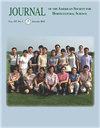Sitosterol-mediated Antioxidant Regulation to Enhance Heat Tolerance in Creeping Bentgrass
IF 1.1
4区 农林科学
Q3 HORTICULTURE
Journal of the American Society for Horticultural Science
Pub Date : 2022-01-01
DOI:10.21273/jashs05107-21
引用次数: 1
Abstract
Heat stress symptoms in cool-season plants are characterized by loss of chlorophyll (Chl) and membrane stability, as well as oxidative damage. The objectives of this study were to determine whether foliar application of β-sitosterol, a naturally occurring plant metabolite, may promote heat tolerance by suppressing heat-induced leaf senescence as indicated by the maintenance of healthy turf quality (TQ), and Chl and membrane stability; and to determine its roles in regulating antioxidant metabolism in creeping bentgrass (Agrostis stolonifera). ‘Penncross’ plants were exposed to heat stress (35/30 °C day/night) optimal temperature conditions (nonstressed control, 22/17 °C day/night) for a duration of 28 days in environment-controlled growth chambers. Plants were foliar-treated with β-sitosterol (400 µM) or water only (untreated control) before heat stress, and at 7-day intervals through 28 days of heat stress. Plants treated with β-sitosterol had significantly greater TQ and Chl content, and significantly less electrolyte leakage (EL) than untreated controls at 21 and 28 days of heat stress. Application of β-sitosterol reduced malondialdehyde (MDA) content significantly at 21 and 28 days of heat stress, and promoted the activities of superoxide dismutase (SOD), peroxidase (POD), catalase (CAT), and ascorbate peroxidase (APX) from 14 through 28 days of heat stress. β-Sitosterol effectively improved heat tolerance through suppression of leaf senescence in creeping bentgrass exposed to heat stress in association with the alleviation of membrane lipid peroxidation and activation of the enzymatic antioxidant system.谷甾醇介导的抗氧化调控提高匍匐曲草的耐热性
冷季植物的热应激症状表现为叶绿素(Chl)和膜稳定性的丧失以及氧化损伤。本研究的目的是确定叶面施用β-谷甾醇(一种天然存在的植物代谢产物)是否可以通过抑制热诱导的叶片衰老来提高耐热性,如维持健康草坪质量(TQ)、叶绿素和膜稳定性所示;并确定其在调节匍匐底栖草(Agrostis stolonifera)抗氧化代谢中的作用Penncross的植物暴露在热胁迫下(35/30 °C昼夜)最佳温度条件(无应力控制,22/17 °C昼夜)在环境控制的生长室中持续28天。在热胁迫前,用β-谷甾醇(400µM)或仅用水(未处理的对照)对植物进行叶面处理,并在热胁迫的28天内每隔7天对植物进行一次处理。在热胁迫的第21天和第28天,用β-谷甾醇处理的植物比未处理的对照组具有显著更高的TQ和Chl含量,以及显著更少的电解质渗漏(EL)。β-谷甾醇在热胁迫21和28天显著降低丙二醛(MDA)含量,并在热胁迫14至28天促进超氧化物歧化酶(SOD)、过氧化物酶(POD)、过氧化氢酶(CAT)和抗坏血酸过氧化物酶(APX)的活性。β-山竹醇通过抑制暴露于热胁迫下的匍匐弯曲草的叶片衰老,同时减轻膜脂质过氧化和激活酶抗氧化系统,有效提高了其耐热性。
本文章由计算机程序翻译,如有差异,请以英文原文为准。
求助全文
约1分钟内获得全文
求助全文
来源期刊
CiteScore
3.80
自引率
0.00%
发文量
31
审稿时长
2 months
期刊介绍:
The Journal of the American Society for Horticultural Science publishes papers on the results of original research on horticultural plants and their products or directly related research areas. Its prime function is to communicate mission-oriented, fundamental research to other researchers.
The journal includes detailed reports of original research results on various aspects of horticultural science and directly related subjects such as:
- Biotechnology
- Developmental Physiology
- Environmental Stress Physiology
- Genetics and Breeding
- Photosynthesis, Sources-Sink Physiology
- Postharvest Biology
- Seed Physiology
- Postharvest Biology
- Seed Physiology
- Soil-Plant-Water Relationships
- Statistics

 求助内容:
求助内容: 应助结果提醒方式:
应助结果提醒方式:


